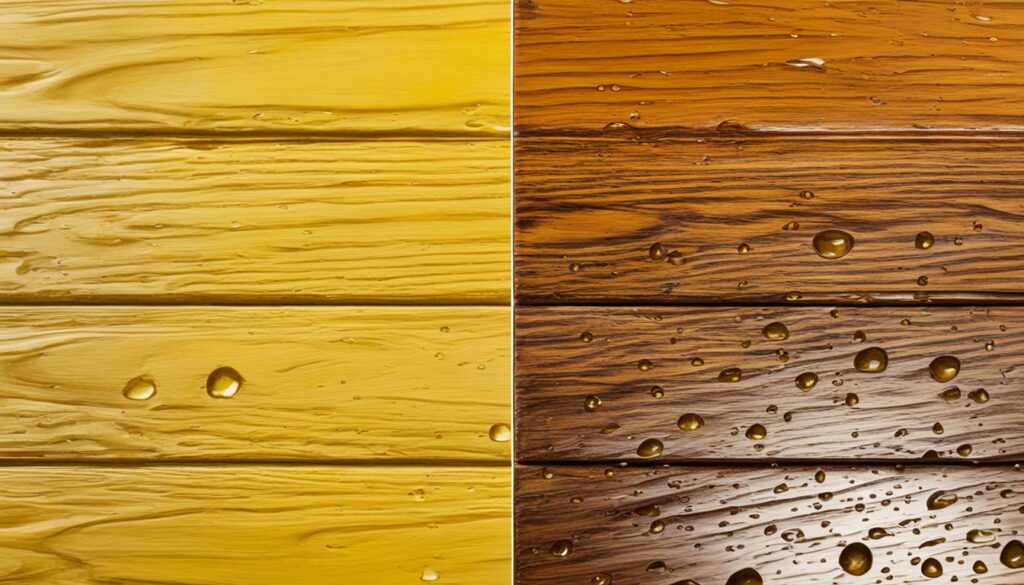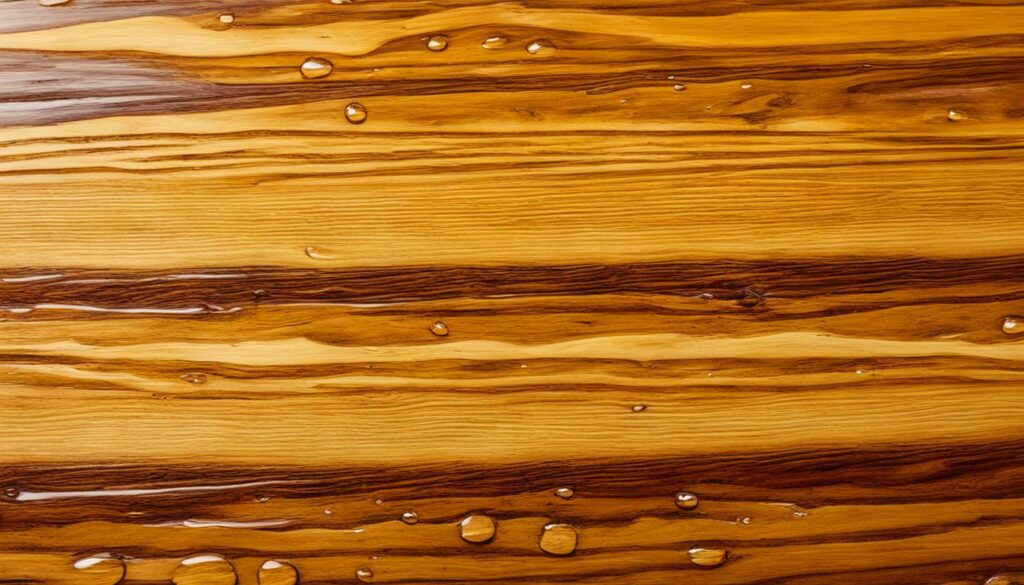Yes, tung oil emits a distinct odor, often described as strong and nut-like, similar to cooking oils. The odor intensity is influenced by the oil’s purity – pure tung oil has a more natural scent, while commercial mixes with solvents produce a stronger, often less pleasant aroma. The smell results from volatile organic compounds (VOCs) released during curing and can linger for weeks to months. Proper ventilation or applying a clear shellac can mitigate the odor. Environmental conditions like humidity and air circulation also impact the rate at which the smell dissipates. For more detailed insights on managing tung oil odor, keep exploring.
Does Tung Oil Smell
Tung oil, known for its robust finishing properties, emits a distinct and often strong odor that can be unpleasant for some individuals. The intensity of the tung oil odor varies based on the type and purity of the oil used. Pure tung oil is characterized by a strong, natural scent that can linger for an extended period, sometimes taking weeks to fully dissipate. This prolonged duration is attributed to the offgassing of volatile organic compounds (VOCs) during the curing process, which releases tung oil fumes into the environment.
In contrast, commercial tung oil mixes often contain solvents or additives that alter the tung oil scent. For instance, Minwax tung oil, a popular commercial product, is noted for having no odor after drying, while other mixes, especially those with citrus solvents, may still emit a strong aroma.
Effective strategies to manage tung oil offgassing include increasing ventilation, applying heat, and reducing humidity, which can expedite the curing process and diminish the tung oil drying odor.
For those sensitive to the tung oil fragrance, sealing the finished surface with a clear shellac coat can effectively lock in the tung oil curing smell, minimizing its detectability and providing a more pleasant user experience.
What Does Tung Oil Smell Like
Understanding the distinct aroma of tung oil involves discerning its nuanced scent profile, which can vary greatly based on its purity and any additives present. Pure tung oil smell is often described as nut-like and somewhat similar to cooking oil, yet more potent. This tung oil smell description underscores the natural, organic scent that some find pleasant, while others may deem it strong but not offensive.
In contrast, commercial tung oil finishes often contain solvents and additives, leading to a markedly different and more intense odor. This tung oil finish smell is frequently characterized as disagreeable or even horrific due to the offgassing of volatile organic compounds (VOCs) during the curing process. Comparatively, the pure tung oil smell is less invasive and dissipates more quickly.
For those applying tung oil to furniture or cutting boards, the tung oil furniture smell and tung oil cutting board smell can linger, necessitating proper tung oil smell ventilation to facilitate dissipation. Practical remedies for mitigating the smell include increasing airflow, applying heat, and reducing humidity.
Opting for low odor tung oil variants or sealing with a clear shellac coat can further minimize the pungency, ensuring a more tolerable and shorter-lived odor.
How Long Does It Take for Tung Oil Smell to Go Away
The duration for the smell of tung oil to dissipate is influenced by various factors, such as the type of tung oil (pure vs. commercial mixes), application thickness, and the environmental conditions during curing.
Pure tung oil, known for its strong, natural odor, often exhibits a prolonged tung oil smell duration, with the lingering smell potentially lasting several weeks to months. Users have reported that the smell intensity of pure tung oil applied in thick coats without adequate ventilation can persist for up to six weeks.
Conversely, commercial tung oil mixes, especially those combined with solvents like citrus, show a reduced tung oil smell strength and shorter duration. For instance, a tung oil and citrus solvent mix may exhibit an odor resembling oranges that dissipates within a week.
Environmental factors play an important role in tung oil smell reduction. Proper ventilation, achieved through the use of fans and maintaining a warm, low-humidity environment, can greatly expedite the offgassing and smell removal process.
Additionally, tung oil smell sealing with a clear shellac coat can effectively lock in the odor, preventing its release and making the tung oil smell less noticeable. Ultimately, achieving a near odorless tung oil finish necessitates careful consideration of these variables for effective tung oil smell absorption and masking.
How To Get Rid Of Tung Oil Smell
Mitigating the persistent and often overpowering smell of tung oil involves employing various techniques. This includes guaranteeing proper ventilation, using sealants like shellac, considering alternative finishing products, and utilizing absorbent materials.
To address the tung oil stench, enhancing air circulation through fans and maintaining low humidity can accelerate the offgassing process. This helps in reducing the tung oil varnish smell more efficiently. A notable method is applying a clear shellac coat to seal the surface once the oil has adequately off-gassed, typically around 30 days. This forms a barrier that mitigates the tung oil persistent odor.
For individuals with tung oil smell sensitivity, exploring tung oil smell elimination methods such as using absorbent materials like baking soda or charcoal can be beneficial. These materials effectively absorb the tung oil flooring smell when placed in proximity to the treated surface. Alternatively, switching to finishes like Arm-R-Seal, which emit a less intense odor and cure faster, serves as a viable tung oil substitute smell.
Addressing tung oil smell complaints from various tung oil smell experiences requires a multifaceted approach. This combines immediate tung oil smell cover-up strategies with long-term solutions to guarantee a more pleasant and manageable finishing process.
Does Tung Oil Odor Last As Long As Linseed Oil Odor
While both tung oil and linseed oil are known for their enduring odors, the duration and persistence of these scents can differ considerably based on the oil type, application method, and environmental factors.
Pure tung oil has a strong, natural smell that can linger for several weeks to months. This tung oil wood smell can be particularly persistent if applied in thick coats without adequate ventilation. The odor can be neutralized to some extent by using fans to increase air circulation and maintaining a warm, low-humidity environment. Additionally, sealing the surface with a clear shellac coat can help lock in the tung oil smell.
On the other hand, boiled linseed oil (BLO) also has a strong, unpleasant smell that can persist for weeks to months. Raw linseed oil, curing more slowly, can have an even more prolonged odor. Environmental factors such as increased temperature and decreased humidity can expedite the offgassing process. However, the linseed oil’s unpleasant smell can still be particularly bothersome for individuals with smell allergies or those prone to headaches.
Is Tung Oil Safe To Use Indoors
Tung oil is generally safe for indoor use due to its non-toxic properties and lack of harmful fumes. Pure tung oil is especially advantageous for interior applications such as kitchen countertops, cutting boards, and children’s toys, given its food-safe characteristics. Unlike many synthetic finishes, it does not emit toxic vapors, ensuring a healthier indoor environment. However, tung oil is not without its challenges, particularly concerning its odor.
Despite its non-toxic nature, the tung oil non-toxic smell can be quite potent and lingering. This odor, while not harmful, can be perceived as an offensive odor by some individuals, potentially causing discomfort or even nausea. Opinions on this smell vary, but precautions should be taken to mitigate its persistence. Effective ventilation is essential; using fans to promote air circulation and maintaining a warm, low-humidity environment can expedite the curing process, thereby reducing the odor duration.
To address tung oil smell guidelines, consider employing air purifiers to reduce the smell and exploring tung oil smell alternatives such as thinning the oil with citrus solvents. Sealing the finished surface with a clear shellac coat can also act as a tung oil smell fix, effectively locking in the odor.
Is Tung Oil Safe To Breathe
In addition to its application safety, understanding whether tung oil is safe to breathe involves examining its chemical profile and potential impacts on individuals with sensitivities or allergies. Pure tung oil, recognized for its non-toxic nature, releases natural volatile compounds such as aldehydes and hydrocarbons during the curing process. These compounds contribute to the characteristic tung oil smell, which, while not harmful to most, can cause discomfort for those with tung oil chemical sensitivity or tung oil allergies.
| Aspect | Details |
|---|---|
| Tung Oil Odor | Persistent, can linger for weeks or months. |
| Ventilation | Essential for reducing tung oil odor, utilizing fans and maintaining a warm, low-humidity environment is recommended. |
| Air Purifiers | Can help mitigate tung oil smell but may not eliminate it entirely. |
Proper tung oil ventilation is critical, especially for indoor use. Ensuring adequate air circulation and employing air purifiers can assist in minimizing exposure to the tung oil odor. For individuals with tung oil chemical sensitivities, it is advisable to test the oil on a small surface area first. Additionally, applying a tung oil clear shellac coat can effectively seal the odor, making tung oil safe for indoor environments, even for those sensitive to its smell. Consequently, while tung oil is generally safe, taking these precautions can enhance comfort and safety during its use.
Alternative Odor-Free Wood Finishes
Considering the increasing demand for low-odor solutions, alternative wood finishes such as water-based polyurethanes, hard wax oils, and plant-based oils offer effective, minimal-odor options for woodworkers and DIY enthusiasts.
Water-based polyurethane finishes from brands like Varathane, General Finishes, and Minwax are low in volatile organic compounds (VOCs) and exhibit greatly reduced odor profiles compared to their oil-based counterparts. This makes them a preferred choice for indoor applications where air quality is a concern.
Hard wax oils, such as Rubio Monocoat, Osmo Polyx, and Loba, are comprised of plant-based components that emit minimal odors and are VOC-free once cured. These finishes provide excellent durability and are often favored in settings requiring minimal olfactory impact.
Plant-based oils like pure tung oil, raw linseed oil, and walnut oil offer a natural alternative with inherently low odor. However, when considering tung oil vs. linseed oil smell, tung oil generally presents a milder scent. Users should verify these oils are 100% pure, devoid of added solvents, to mitigate tung oil smell dizziness and other adverse reactions.
Tung oil smell reviews often highlight individual preferences, tolerances, and aversions, emphasizing the importance of testing small areas first to evaluate tung oil smell safety, toxicity, and associated risks.
Welcome to WoodCraftYard.com, your one-stop destination for all things woodworking! I’m Oliver Candler, a dedicated woodworking aficionado and the creative mind behind this virtual woodworking haven. With a deep-rooted love for craftsmanship and a keen eye for detail, I am on a mission to share my passion for woodworking with fellow enthusiasts like yourself.
As a seasoned woodworker, I am committed to providing you with valuable insights, practical tips, and inspiring project ideas to help you unleash your creativity and master the art of woodworking. Whether you’re a seasoned pro or just starting out on your woodworking journey, join me as we carve, sand, and saw our way through the world of woodworking together.
Let’s embark on this woodworking adventure, where every knot, grain, and finish tells a unique story. Together, let’s craft, create, and build something truly extraordinary at WoodCraftYard.com!



